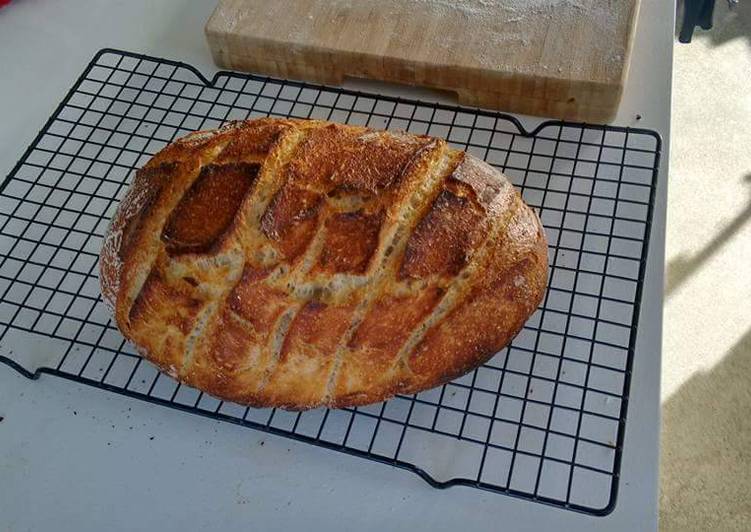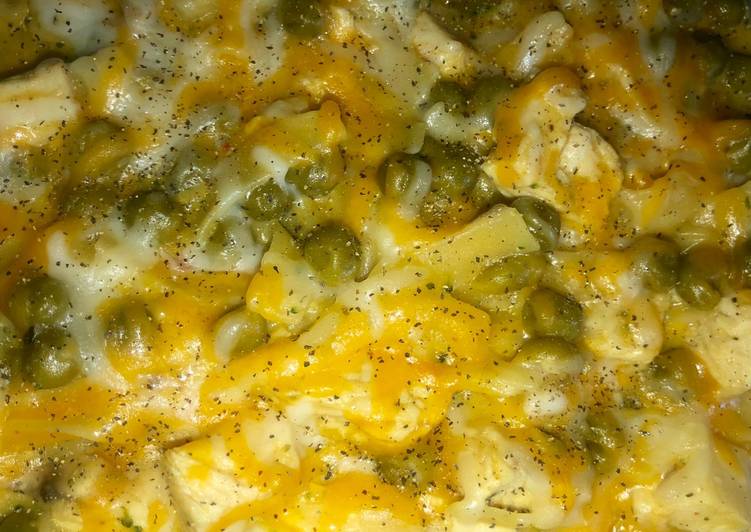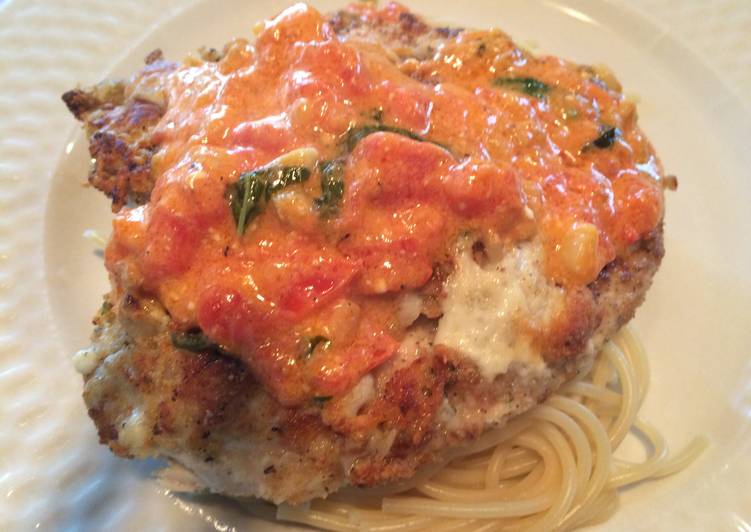
Hey everyone, it is Brad, welcome to my recipe page. Today, I will show you a way to prepare a special dish, sour dough bread - the holy grail of home bakers. One of my favorites food recipes. This time, I will make it a little bit tasty. This is gonna smell and look delicious.
Sour Dough Bread - The Holy Grail of Home Bakers is one of the most popular of recent trending meals on earth. It’s appreciated by millions daily. It’s easy, it’s fast, it tastes yummy. They are nice and they look fantastic. Sour Dough Bread - The Holy Grail of Home Bakers is something that I have loved my entire life.
To begin with this particular recipe, we have to prepare a few ingredients. You can cook sour dough bread - the holy grail of home bakers using 9 ingredients and 15 steps. Here is how you cook it.
The ingredients needed to make Sour Dough Bread - The Holy Grail of Home Bakers:
- Make ready For STARTER and LEAVEN
- Take 500 g White-bread flour
- Take 500 g Whole-wheat flour
- Get for the bread
- Make ready 200 g leaven
- Get 900 g White-bread flour
- Get 100 grams whole-wheat flour, plus more for dusting
- Take 20 grams fine sea salt
- Get 100 grams rice flour
Steps to make Sour Dough Bread - The Holy Grail of Home Bakers:
- Make the starter: Combine 500 grams white-bread flour with 500 grams whole-wheat flour. Put 100 grams of warm water (about 80 degrees) in a small jar or container and add 100 grams of the flour mix. Use your fingers to mix until thoroughly combined and the mixture is the consistency of thick batter. Cover with a towel and let sit at room temperature until mixture begins to bubble and puff, 2 to 3 days.
- When starter begins to show signs of activity, begin regular feedings. Keep the starter at room temperature, and at the same time each day discard 80 percent of the starter and feed remaining starter with equal parts warm water and white-wheat flour mix (50 grams of each is fine). When starter begins to rise and fall predictably and takes on a slightly sour smell, it’s ready; this should take about 1 week.(Reserve remaining flour mix for leaven.)
- Make the leaven: The night before baking, discard all but 1 tablespoon of the mature starter. Mix the remaining starter with 200 grams of warm water and stir with your hand to disperse. Add 200 grams of the white-wheat flour mix and combine well. Cover with a towel and let rest at room temperature for 12 hours or until aerated and puffed in appearance. To test for readiness, drop a tablespoon of leaven into a bowl of room-temperature water; if it floats it’s ready to use.
- Make the dough: In a large bowl, combine 200 grams of leaven with 700 grams of warm water and stir to disperse. (Reserve remaining leaven for future loaves; see note below.)
- Add 900 grams of white-bread flour and 100 grams of whole-wheat flour to bowl and use your hands to mix until no traces of dry flour remain. The dough will be sticky and ragged. Cover bowl with a towel and let dough rest for 25 to 40 minutes at room temperature.
- Add 20 grams fine sea salt and 50 grams warm water. Use hands to integrate salt and water into dough thoroughly. The dough will begin to pull apart, but continue mixing; it will come back together.
- Cover dough with a towel and transfer to a warm environment, 75 to 80 degrees ideally (like near a window in a sunny room, or inside a turned-off oven). Let dough rise for 30 minutes. Fold dough by dipping hand in water, taking hold of the underside of the dough at one quadrant and stretching it up over the rest of the dough. Repeat this action 3 more times, rotating bowl a quarter turn for each fold. Do this every half-hour for 2 1/2 hours more (3 hours total). The dough should be billowy.
- Transfer dough to a work surface and dust top with flour. Use a dough scraper to cut dough into 2 equal pieces and flip them over so floured sides are face down. Fold the cut side of each piece up onto itself so the flour on the surface remains entirely on the outside of the loaf; this will become the crust. Work dough into taut rounds. Place the dough rounds on a work surface, cover with a towel, and let rest 30 minutes.
- Mix 100 grams whole-wheat flour and 100 grams rice flours. Line two 10- to 12-inch bread-proofing baskets or mixing bowls with towels. Use some of the flour mixture to generously flour towels (reserve remaining mixture).
- Dust rounds with whole-wheat flour. Use a dough scraper to flip them over onto a work surface so floured sides are facing down. Take one round, and starting at the side closest to you, pull the bottom 2 corners of the dough down toward you, then fold them up into the middle third of the dough. Repeat this action on the right and left sides, pulling the edges out and folding them in over the center. Finally, lift the top corners up and fold down over previous folds.
- (Imagine folding a piece of paper in on itself from all 4 sides.) Roll dough over so the folded side becomes the bottom of the loaf. Shape into a smooth, taut ball. Repeat with other round.
- Transfer rounds, seam-side up, to prepared baskets. Cover with a towel and return dough to the 75- to 80-degree environment for 3 to 4 hours. (Or let dough rise for 10 to 12 hours in the refrigerator. Bring back to room temperature before baking.)
- About 30 minutes before baking, place a Dutch oven or lidded cast-iron pot in the oven and heat it to 500 degrees. Dust tops of dough, still in their baskets, with whole-wheat/rice-flour mixture. Very carefully remove heated pot from oven and gently turn 1 loaf into pan seam-side down. Use a lame (a baker’s blade) or razor blade to score the top of the bread a few times to allow for expansion, cover and transfer to oven. Reduce temperature to 450 degrees and cook for 20 minutes.
- Carefully remove lid (steam may release) and cook for 20 more minutes or until crust is a rich, golden brown color.
- Transfer bread to a wire rack to cool for at least 15 minutes before slicing. The bottom of the loaf should sound hollow when tapped. Increase oven temperature to 500 degrees, clean out pot and repeat this process with the second loaf.
Foods That Make You Happy
Mostly, people have been taught to think that “comfort” foods are bad for the body and must be avoided. At times, if your comfort food is made of candy or other junk foods, this is true. Otherwise, comfort foods could be super nutritious and good for you. Several foods really do improve your mood when you eat them. If you seem to feel a little bit down and need a happiness pick me up, try some of these.
Eggs, believe it or not, can be actually great at beating back depression. Just see to it that you do not throw out the yolk. Every time you want to cheer yourself up, the egg yolk is the most crucial part of the egg. Eggs, the yolks in particular, are loaded with B vitamins. B vitamins can truly help you elevate your mood. This is because these vitamins improve the function of your brain’s neural transmitters (the parts of the brain that dictate how you feel). Try eating an egg and jolly up!
Make a few trail mix of nuts or seeds. Your mood can be raised by eating peanuts, almonds, cashews, sunflower seeds, pumpkin seeds, and so on. This is because these nuts are loaded with magnesium, which helps to raise serotonin production. Serotonin is the “feel good” chemical that dictates to your brain how you feel all the time. The more of this chemical in your brain, the better you’ll feel. Nuts, on top of bettering your mood, can be a super protein source.
Cold water fish are great if you would like to feel better. Salmon, herring, tuna fish, mackerel, trout, etc, they’re all high in omega-3 and DHA. DHA and omega-3s are two things that improve the quality and the function of your brain’s grey matter. It’s the truth: consuming tuna fish sandwiches can really help you battle your depression.
Some grains are actually excellent for driving away bad moods. Barley, millet, quinoa, etc are great at helping you feel better. These foods fill you up better and that can help improve your moods as well. Feeling starved can really make you feel terrible! These grains can improve your mood since it’s easy for your body to digest them. They are simpler to digest than other foods which helps raise your blood sugar levels and that, in turn, improves your mood.
Your mood could truly be helped by green tea. You were just waiting to read that here, weren’t you? Green tea is loaded with a certain amino acid referred to as L-theanine. Studies have found that this particular amino acid can basically induce brain waves. This will improve your brain’s focus while also relaxing the rest of your body. You were already aware that that green tea helps you be healthier. Now you know that it helps you to raise your moods also!
Now you can see that junk food isn’t necessarily what you should eat when you wish to help your moods get better. Try a couple of of these tips instead.


